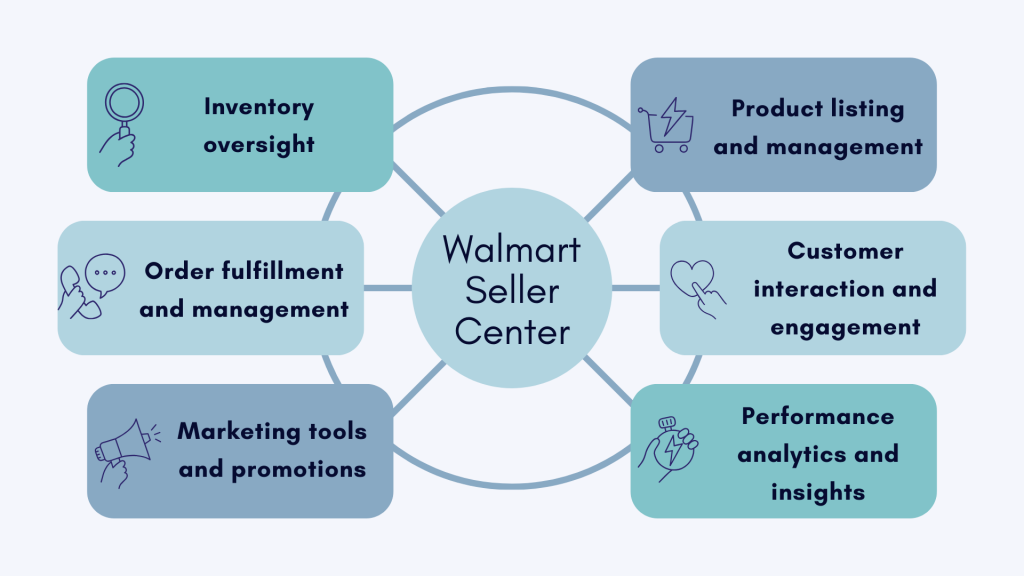Walmart is a retail giant, offering a thriving marketplace for businesses to expand their reach and boost sales.
In this article, we will explore the Walmart Seller Center—a pivotal hub for Walmart marketplace sellers—and delve into its purpose, standout features, and the undeniable benefits it brings to businesses aiming to thrive in the digital retail realm.
Key takeaways
- Walmart Marketplace provides third-party sellers with access to millions of online shoppers, leveraging Walmart’s robust infrastructure for efficient logistics, payment processing, and customer support.
- Walmart Seller Center equips sellers with comprehensive tools for product management, order fulfillment, inventory tracking, performance analytics, and customer engagement, ensuring streamlined operations and enhanced customer satisfaction.
- By utilizing strategic tools like the Assortment Growth Dashboard and the Repricer, sellers can effectively expand their product catalogs, stay competitive in pricing, and boost sales on the Walmart platform.
What’s Walmart?
Walmart, officially known as Walmart Inc., is a multinational retail corporation and one of the world’s largest and most influential retailers. Founded in 1962 by Sam Walton, the company has its headquarters in Bentonville, Arkansas. Walmart operates a vast network of discount department stores, hypermarkets, and grocery stores, making it a ubiquitous presence in the retail industry. With a significant footprint in the United States and a growing international presence, Walmart has become synonymous with offering a wide range of products at competitive prices, catering to the diverse needs of consumers.
Known for its commitment to providing value for customers, Walmart has pioneered various retail innovations, such as its renowned supply chain management system, which enables the company to deliver cost-effective products. Beyond its brick-and-mortar stores, Walmart has successfully expanded into the digital realm with a robust e-commerce platform, Walmart.com, offering customers the convenience of online shopping. The company’s influence extends to various sectors, and it continues to play a pivotal role in shaping the landscape of retail, both in the United States and around the world.
What’s Walmart Marketplace?
Walmart Marketplace is an expansive online platform that serves as a digital marketplace where third-party sellers can list and sell their products alongside Walmart’s own inventory. Functioning as an e-commerce ecosystem, the Walmart Marketplace allows businesses to tap into Walmart’s vast customer base, providing them with a unique opportunity to reach millions of online shoppers.
Let’s look at how it benefits businesses and customers.
- Diverse product categories
Walmart Marketplace boasts a diverse array of product categories, ranging from electronics and apparel to home goods and beyond. This extensive selection caters to a wide range of consumer needs, ensuring that customers can find and purchase products across various segments, making it a one-stop destination for online shopping. - Millions of online shoppers
With Walmart’s Marketplace, businesses gain access to an immense customer base, consisting of millions of online shoppers. This vast reach provides sellers with a unique opportunity to showcase their products to a broad audience, increasing visibility and the potential for sales. The platform’s popularity and the trust associated with the Walmart brand contribute to a steady flow of potential customers. - Established infrastructure
Sellers on Walmart Marketplace benefit from the retail giant’s well-established infrastructure. This includes access to a robust logistics network, allowing for efficient order fulfillment and delivery. Leveraging Walmart’s infrastructure can significantly streamline the supply chain for sellers, ensuring timely and reliable shipping to customers. - Payment processing integration
The platform integrates seamless payment processing, providing a hassle-free experience for both sellers and customers. Walmart Marketplace handles transactions securely, offering various payment options to cater to diverse customer preferences. This integration simplifies the payment process for sellers, allowing them to focus on delivering quality products and services. - Customer support assistance
Sellers joining Walmart Marketplace can rely on the platform’s dedicated customer support. Whether addressing inquiries about products, managing returns, or resolving other issues, the support system enhances the overall seller and customer experience. This level of assistance contributes to a positive reputation for sellers, fostering customer trust and loyalty. - Fostering healthy competition
The marketplace encourages healthy competition among sellers, driving them to offer competitive pricing, high-quality products, and excellent customer service. This competitive environment benefits customers by providing a variety of choices and ensures that sellers continually strive to improve their offerings to stand out in the marketplace. - Opportunity for growth
For sellers, Walmart Marketplace represents not only a platform for immediate sales but also an opportunity for long-term growth. By associating with the Walmart brand and tapping into its expansive customer base, businesses can build brand recognition and establish themselves as trusted online retailers, paving the way for sustained success in the competitive e-commerce landscape.
Wallmart Seller Center: the heart of Walmart’s Marketplace
Walmart Seller Center is a platform for third-party merchants aiming to establish and expand their online presence on Walmart’s ecommerce marketplace. Like a Swiss Army knife for sellers, it provides a range of tools that empower third-party merchants to succeed in ecommerce. With features covering product management, order fulfillment, inventory tracking, analytics, and customer interactions, Seller Center becomes an indispensable ally for sellers in navigating challenges and opportunities of the industry with finesse.
Let’s look at its features in more detail.

Product listing and management
Walmart Seller Center enables sellers to effortlessly create and manage product listings. Sellers have the flexibility to input detailed product information, upload high-quality images, and set competitive pricing strategies. This feature ensures that their products are accurately represented to potential customers browsing the Walmart marketplace.
- Effortless product listing
With Walmart Seller Center, sellers can easily craft and publish product listings without getting lost in a maze of complicated procedures. The intuitive interface allows for quick and straightforward entry of essential details, eliminating unnecessary hurdles in the listing process. - Detailed product information
Sellers can go beyond the basics, offering potential customers a comprehensive understanding of their products. This includes specifications, features, and any other relevant information that might influence a buyer’s decision. For instance, a seller of electronic gadgets can highlight technical specifications, warranty details, and unique features directly through the Seller Center. - High-quality visuals
A picture is worth a thousand words, and Seller Center recognizes this by enabling sellers to upload high-quality images. Whether it’s showcasing the intricate details of a piece of jewelry or providing multiple angles of an electronic device, the platform ensures that the visual representation aligns with the product’s actual attributes, captivating customers and fostering trust. - Strategic pricing
Setting the right price is an art, and Seller Center empowers sellers to be strategic in their approach. Sellers can implement competitive pricing strategies tailored to market trends, competitor pricing, and their own cost considerations. For instance, a seller entering the beauty product niche can use Seller Center to adjust prices in response to promotions or seasonal trends, staying agile in a dynamic market.
Order fulfillment and management
Efficient order management is at the core of Seller Center’s functionality. Sellers can monitor incoming orders, track fulfillment processes, and manage shipping logistics. This ensures a seamless and timely delivery experience for customers, contributing to overall satisfaction and positive reviews.
- Real-time order monitoring
Seller Center keeps sellers in the loop with real-time order updates. Sellers can monitor incoming orders as they happen, allowing for immediate response and action. This real-time visibility ensures that sellers are always on top of their game, reducing the risk of overselling and providing a responsive approach to customer demands. - Fulfillment tracking
Efficient fulfillment is key to meeting customer expectations. Seller Center allows sellers to track each step of the fulfillment process, from order confirmation to packaging and shipment. This granular tracking capability provides transparency and accountability, enabling sellers to identify and address any bottlenecks in their fulfillment workflows. - Shipping logistics management
Seller Center streamlines shipping logistics, allowing sellers to manage carriers, shipping methods, and delivery timelines. This feature is instrumental in optimizing the shipping process, reducing delays, and providing customers with accurate delivery estimates. - Enhancing customer satisfaction
The seamless orchestration of order management, fulfillment tracking, and logistics within Seller Center translates into a positive customer experience. Timely and accurate deliveries contribute significantly to customer satisfaction, fostering loyalty and encouraging positive reviews.
Inventory oversight
Maintaining accurate inventory levels is crucial for successful online retail. Seller Center empowers sellers to monitor and update their inventory in real-time. This dynamic inventory management capability helps prevent overselling and ensures that product availability is consistently reflected on the Walmart platform.
- Real-time inventory tracking
Seller Center offers a real-time monitoring system that allows sellers to keep a constant eye on their inventory status. Sellers can instantly track changes in stock levels, ensuring they are always aware of the quantities available for each product. - Automatic updates
The platform supports automatic updates, minimizing the need for manual intervention. As soon as a sale is made or new stock is added, Seller Center automatically adjusts the inventory levels, providing accurate and up-to-the-minute information. - Preventing overselling
One of the primary concerns in online retail is overselling, which can lead to customer dissatisfaction. Seller Center’s dynamic inventory management feature includes safeguards to prevent overselling by updating product availability in real time, eliminating the risk of selling more units than are physically in stock. - Order synchronization
The platform synchronizes seamlessly with the order processing system, ensuring that the inventory is adjusted promptly when an order is placed. This synchronization helps maintain accuracy across the entire order fulfillment process. - Low-stock alerts
To proactively manage inventory levels, Seller Center often includes a feature that provides alerts when stock levels fall below a predefined threshold. Sellers receive timely notifications, allowing them to restock before products run out, minimizing the chances of missed sales opportunities. - Customizable settings
Seller Center typically allows sellers to customize inventory settings according to their preferences. Sellers can set reorder points, establish safety stock levels, and tailor the system to align with their specific business needs. - Historical data and trends
The platform may offer tools to analyze historical inventory data and trends. Sellers can leverage this information to make informed decisions about stock levels, identify popular products, and plan for seasonal fluctuations in demand.
Performance analytics and insights
Informed decision-making is essential for sellers looking to optimize their strategies. Walmart Seller Center provides comprehensive performance analytics, offering insights into sales trends, customer feedback, and other key metrics. This data-driven approach enables sellers to identify areas for improvement and capitalize on successful practices.
- Sales trends analysis
Seller Center’s performance analytics feature provides a granular examination of sales trends over specific periods. Sellers can identify patterns, such as peak sales times, seasonal variations, and product-specific trends, allowing for informed inventory management and marketing strategies. - Customer feedback metrics
Beyond sales numbers, Seller Center offers a detailed overview of customer feedback. Sellers can access and analyze customer reviews, ratings, and comments to understand customer satisfaction levels and identify areas for improvement in product quality, customer service, or other aspects of the shopping experience. - Conversion rates and funnel analysis
The platform often includes tools to assess conversion rates and analyze the sales funnel. Sellers can pinpoint where potential customers drop off in the purchasing process, helping them optimize product listings, streamline the checkout process, and ultimately boost conversion rates. - Product performance metrics
Seller Center provides insights into the performance of individual products.Sellers can evaluate which products are top performers and which may need attention, enabling them to allocate resources effectively, optimize marketing efforts, and make data-driven decisions on product offerings. - Competitor benchmarking
Some iterations of Seller Center may offer features for benchmarking against competitors. Sellers can compare their performance metrics with industry benchmarks, helping them gauge their competitiveness and identify areas where they can outperform or differentiate themselves. - Customizable reporting
The platform often allows sellers to create customizable reports based on their specific metrics of interest. Sellers can tailor reports to focus on particular aspects of their business, making it easier to extract actionable insights that align with their strategic goals. - Trend forecasting
Seller Center may include tools for trend forecasting based on historical data. Sellers can anticipate future market trends, enabling proactive adjustments to inventory, marketing strategies, and overall business plans. - Integration with marketing tools
In some cases, Seller Center integrates with marketing tools, providing a seamless connection between analytics and marketing efforts. Sellers can optimize their marketing campaigns based on data insights, ensuring that promotional activities align with consumer behavior and market trends.
Customer interaction and engagement
Effective communication with customers is facilitated through Seller Center. Sellers can engage with customers, respond to inquiries, and manage customer feedback and reviews. Building positive relationships with customers contributes to brand loyalty and enhances the overall shopping experience.
- Direct communication channels
Seller Center serves as a hub for direct communication between sellers and customers. It provides a messaging system that allows sellers to promptly respond to customer inquiries, providing real-time assistance. - Inquiry management
Sellers can efficiently manage and organize customer inquiries within Seller Center. This includes questions about product details, shipping, or any other concerns customers might have before making a purchase. - Feedback and reviews management
The platform offers a centralized space for sellers to monitor and respond to customer feedback and reviews. Sellers can address both positive and negative feedback, showcasing a commitment to customer satisfaction. - Timely responses
Sellers are encouraged to respond to customer inquiries and feedback promptly. Quick responses not only address customer concerns in a timely manner but also contribute to an image of reliability and attentiveness. - Personalized customer engagement
Seller Center allows for personalized engagement with customers. Sellers can tailor their responses based on individual customer needs and preferences, fostering a sense of connection and understanding. - Resolution of issues
In cases where customers encounter problems, Seller Center facilitates issue resolution. Sellers can efficiently address issues such as damaged products, late deliveries, or other concerns, demonstrating a commitment to customer satisfaction. - Promotion of positive experiences
Sellers can use Seller Center to highlight positive customer experiences. Sharing success stories, testimonials, or customer photos can contribute to a positive brand image and encourage trust among potential customers. - Brand loyalty building
Building positive relationships through effective communication contributes to brand loyalty. Customers are more likely to return to a seller they perceive as responsive, trustworthy, and committed to their satisfaction. - Surveys and feedback requests
Seller Center may offer tools for sellers to gather more structured feedback through surveys or requests for customer opinions. This valuable input can be used to enhance products, services, and overall customer experience. - Communication analytics
Some versions of Seller Center provide analytics on communication metrics. Sellers can track response times, customer satisfaction levels, and other relevant data to continually refine their communication strategies.
Marketing tools and promotions
Some iterations of Seller Center may offer marketing tools and features. Sellers can leverage promotional campaigns and marketing initiatives to increase product visibility and drive sales. This aspect allows sellers to actively participate in the growth and promotion of their product catalog on the Walmart marketplace.
- Promotional campaigns
Seller Center often provides a user-friendly interface for creating and launching promotional campaigns. Sellers can design targeted promotions, such as discounts, bundles, or limited-time offers, to capture the attention of potential customers and encourage conversions. - Discounts and special offers
Sellers can set up discounts on specific products or offer special deals, fostering a sense of urgency and prompting customers to make a purchase. These promotional pricing strategies can be customized to align with sales goals and seasonal trends. - Coupon code management
Some iterations of Seller Center include tools for managing coupon codes. Sellers can generate unique codes for promotions, track their usage, and measure the effectiveness of different coupon campaigns. - Ad campaign integration
Integration with Walmart’s advertising platform may be available, allowing sellers to seamlessly create and manage sponsored product ads directly from Seller Center. This feature enables sellers to boost the visibility of their products on the platform through targeted advertising. - Performance analytics for campaigns
Seller Center typically provides analytics and performance metrics for marketing campaigns. Sellers can track key metrics such as click-through rates, conversion rates, and return on investment, gaining valuable insights into the effectiveness of their promotional efforts. - Customizable landing pages
Some versions of Seller Center may allow sellers to create customizable landing pages for their promotions. This feature enables sellers to curate a unique online shopping experience, showcasing featured products and promotions in an engaging way. - Targeted email campaigns
Sellers may have the option to integrate email marketing campaigns through Seller Center. This functionality allows sellers to reach out to their customer base with targeted emails, informing them about ongoing promotions, new product launches, or exclusive offers. - Seasonal and event campaign planning
Seller Center often supports the planning and execution of campaigns aligned with seasonal events, holidays, or special occasions. Sellers can strategize and schedule promotions to capitalize on peak shopping periods and consumer behavior. - A/B testing capabilities
Some versions of Seller Center may include A/B testing features, allowing sellers to experiment with different aspects of their campaigns. Sellers can test variations in messaging, visuals, or promotion types to optimize their marketing strategies based on real-time performance data.
Unlocking success on Walmart Marketplace: A seller’s guide to catalog expansion and sales boost
Walmart Marketplace sellers well aware of the immense potential it holds, with a staggering 85% of Walmart.com shoppers making at least one online purchase per month. However, to truly capitalize on this opportunity, sellers must not only adapt but continually evolve their Marketplace catalog to align with consumer preferences. At this point, they might want to consider following some proven strategies and tools that can elevate their selling experience, expanding their product catalogs and propelling sales to new heights.
Tapping into market research and strategic partnerships
Bolstering your presence on Walmart Marketplace might require thorough market research, establishing direct ties with manufacturers for unique product access, seizing networking opportunities at trade events, and strategically exploring adjacent product categories for a comprehensive and successful catalog expansion strategy.
In-depth market research
Understanding consumer trends, preferences, and demands is the first step to catalog expansion. Dive into available data, explore industry reports, and analyze customer feedback to elevate your presence on the platform.
Direct relationships with manufacturers
Forge direct connections with manufacturers specializing in your business’s relevant categories. This move can grant you access to unique product lines, enable negotiation for favorable pricing, and provide better control over inventory quality and availability.
Networking opportunities
Trade events are not just about showcasing your products. They can be golden opportunities to connect with industry experts. Attend relevant events to build valuable relationships, stay abreast of the latest market trends, and gain insights that can inform your catalog expansion strategy.
Exploring adjacent categories
Take a strategic approach to product expansion by considering items that complement your existing catalog. For instance, if you’re selling dresses, think about venturing into handbags, shoes, or accessories.
Tip: Evaluate the profitability of expanding into adjacent areas through thorough market research, assessing customer overlap, demand potential, and competition.
Assortment Growth Dashboard: a catalog expansion game-changer
The Assortment Growth Dashboard is more than just a tool. It’s a game-changer for catalog growth. By leveraging customer demand signals and category data, this dashboard provides data-driven suggestions for best-selling items across various categories and brands.
Personalized recommendations
Explore the dashboard to receive personalized product recommendations aligned with your business goals. The quick set-up item action makes adding these items to your catalog a breeze.
Effective utilization
Leverage columns and filters, including “Demand season,” to get ahead of the competition and increase your visibility. Make it a routine to revisit the dashboard for new suggestions, ensuring you’re among the first to add trending brands and products to your catalog.
Tip: Always listen to customer feedback and reviews to understand preferences and continuously improve your products.
Repricer: staying competitive in pricing
Adding products to your catalog is just the beginning; ensuring they sell is equally crucial. The Repricer tool dynamically adjusts your prices to meet or beat competitor prices, increasing your chances of attracting more customers and winning the Buy Box.
Strategic repricing
Choose from preset strategies or create custom ones that align with your pricing goals. Dynamically reprice items using strikethrough promo pricing to stand out and attract more customers.
Real results
Sellers using Repricer since October 2022 reported remarkable results, including a substantial increase in price competitiveness, Buy Box win rate, and overall GMV lift.
Monitoring Buy Box performance
Keep a close eye on your win rate via the Buy Box Report. API users can even subscribe to push notifications to stay informed when items win or lose the Buy Box.
Tip: The Repricer is a powerful tool, but always keep an eye on customer feedback to understand how you can improve.
Conclusion
To wrap it up, the Walmart Seller Center might be a game-changer for businesses seeking to establish a strong online presence. From efficient product management to the coveted Pro Seller Badge, the Seller Center empowers marketplace sellers to navigate the digital marketplace with confidence, ensuring success in online retail. As businesses harness the capabilities of Walmart Seller Center, they unlock new opportunities for growth, visibility, and sustained success in the dynamic ecommerce landscape.
Continue reading: What’s Walmart business account?
Share your thoughts
Are you a Walmart Marketplace seller? Share your experience with Walmart Seller Center in the comments section below!

.png)




